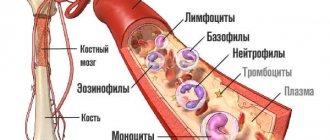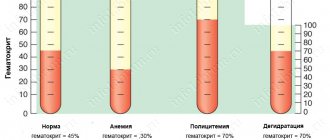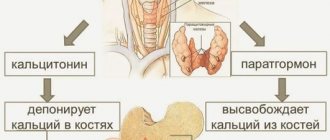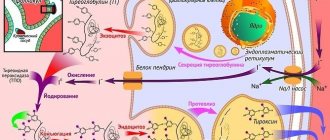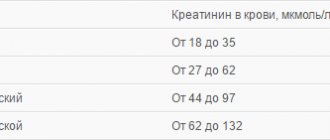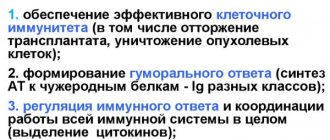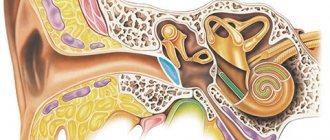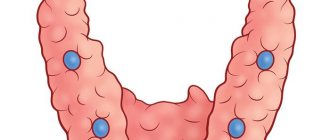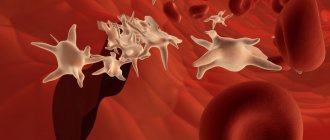The prothrombin index is a diagnostic indicator that demonstrates the speed and quality of blood clotting. The calculations are based on the proportional ratio of the time required to change the properties of the plasma and the period taken as the conventional norm.
Next, based on the calculation results, a certain percentage is obtained, which becomes the desired value. Adequate levels are determined by age, but in general, there are no significant differences between years.
The prothrombin index (abbreviated PTI) is used in the practice of hematologists for early examination and detection of various forms of diseases and coagulopathies.
Treatment is not always necessary. Transient types of disturbance are possible. Next, corrective measures are prescribed as needed. Strictly under the supervision of doctors.
Prothrombin index - what is it?
Prothrombin is a protein compound necessary for complete blood clotting. It is produced in the liver. A prothrombin test is needed to assess blood clotting. The most common and universal method for this is Quick prothrombin.
The test reveals the activity of prothrombin in the blood in comparison with certain indicators. This is the ratio of the time at which plasma clotting occurs relative to the same process in the sample.
It is worth noting that the Quick prothrombin test is performed not only to assess blood clotting, but also to understand whether the liver and gastrointestinal tract are functioning properly.
Decoding INR
The international normalized ratio is a classic technique. Only one test tube is used, which reduces accuracy, but at the same time allows for rapid research.
The indicator, in contrast to the more detailed method (according to Quick), deviates insignificantly. At least not to the extent that the changes are critical and do not allow clinically correct conclusions to be drawn. That's why this variation is used more often.
The INR can be calculated as a percentage or as a coefficient. The first option was discussed in the table above, and in the latter case it is determined by a decimal fraction, and the range from 0.82 to 1.15 is considered normal. For diseases of the cardiovascular system and lungs, it is possible to increase the level to 3.0.
Prothrombin time - what is it?
Depending on what caused the bleeding, blood can clot in several ways - internal or external. In the first case, this is due to the fact that the vessels are damaged from the outside. This can happen due to abrasions, bites or bruises. In the second case, the integrity of the walls of blood vessels from the inside occurs. This is caused by toxins, antibodies, and various pathogenic microorganisms.
Prothrombin time is an indicator by which you can understand how the internal pathway works in the hemocoagulation system.
Prothrombin time increases as a result of the following factors:
The body lacks vitamin K.
Kidney pathologies.
Taking certain medications.
The bile ducts are blocked or inflamed.
Absorption of fats in the intestines is impaired.
The more prothrombin in the blood is lowered, the higher the prothrombin time will be, because in this state the clotting process will be slowed down.
Prothrombin-lowering factors can be:
- A decrease in petit occurs in women who are carrying a baby.
- Syndrome – DIC.
- There is a deviation from the norm of hematocrit.
Prothrombin time may show a low result if the blood was taken incorrectly or the plasma was stored for a very long time before the study.
Unity and struggle of opposites
Disturbances in the hemostasis system lead to the development of coagulopathies, where pathology with a tendency to thrombosis is usually designated by the term “thrombophilia,” and diseases that are accompanied by increased bleeding are called “hemorrhagic diathesis.” Violations of blood coagulation abilities can be hereditary in nature or result from conditions formed during life (diseases of the liver parenchyma, vitamin K deficiency, the use of anticoagulants for medicinal purposes, activation of the fibrinolytic system).
The development of hemocoagulation disorder syndrome is caused by the loss (or decrease) of the ability of liver cells to biosynthesize coagulation factors. Moreover, it should be noted that the factors of the coagulation, anticoagulation and fibrinolysis systems do not exist in isolation; disruption of the activity of any one link leads to pathological conditions of other components. For example:
- A disorder in the biosynthesis of the protein we are considering, prothrombin, will certainly entail a disruption in the production of other factors (VII, IX, X) and a deficiency of all components of the prothrombin complex, which will subsequently result in a decrease in the activity of FV, an increase in the concentration of fibrin monomers, a decrease in the activity of FXIII and an increase in the ability of fibrin to lysis.
- Disruption of fibrinogen metabolism will cause a change in the structural structure of the profibrin layer of blood vessels, opening the way for the movement of red blood cells through the vascular walls.
The combination of seemingly completely opposite properties of the above systems (provided they are functioning normally) ensures the liquid state of blood, freely moving through all the blood vessels of the body, and its coagulation if there is a need to patch a gap formed as a result of tissue damage.
What is prothrombin index?
PTI in the blood is an indicator that reflects the speed at which blood coagulation starts along its internal pathway. It is calculated based on prothrombin time. A low prothrombin index is associated with the same factors as a decrease in PT.
The normal prothrombin index for women is approximately 95%. The normal prothrombin index in men is slightly higher and is about 105%. The accuracy of the analysis depends on many factors, for example, the drugs used in the laboratory.
How are prothrombin tests performed?
The essence of almost all methods for studying the activity of the prothrombin complex is to calculate the time of formation of a fibrin clot immediately after adding activators to the blood, as well as comparing this time with normal values.
Blood is drawn into a test tube with an anticoagulant (sodium citrate). The test tube with citrated blood is slightly heated in a water bath. A reagent consisting of thromboplastin and calcium chloride is added to it. The time of loss of fibrin fibers is measured using a stopwatch. This is prothrombin time (PT). Its normal value is 11-15 seconds.
Having determined the patient's PT, it is compared with the normal prothrombin time (PT). It is usually indicated on the reagent bottle and depends on the activity of the thromboplastin used. Usually this figure is from 12 to 18 seconds (it may be different in each new reagent sample). The ratio of PVN to PT of the subject, expressed as a percentage, is the prothrombin index (PI). Its normal value is 80-105%. The longer the blood clotting time (PT), the lower the PI, which will indicate hypocoagulation.
Why is prothrombin high?
If prothrombin according to Quick is increased and its value is 150% or more, then there may be many reasons for this:
Diseases in which the activity of vitamin K decreases several times.
A syndrome called DIC.
Various pathologies acquired during life or hereditary, for example, amyloidosis, nephrotic syndrome, etc.
Increased prothrombin may also occur if you have taken the following medications for a long time:
Antibiotics or anabolics.
Aspirin.
Diuretic drugs.
A nicotinic acid.
Inhibitors or heparin.
Prothrombin according to Quick is normal if its value is approximately 100-120%.
Reasons for increased prothrombin and PTI
An increase in PTI indicates hypercoagulation and is dangerous for the development of thrombosis (heart attacks, strokes, thrombosis of the veins in the legs, pulmonary embolism). This condition is especially unfavorable after operations and after childbirth.
- Last weeks of pregnancy.
- DIC – syndrome (1st stage).
- The use of estrogen-containing hormones by women (and sometimes men).
- Congenital thrombophilia.
- Excess vitamin K.
- Mutation of the prothrombin gene G20210A (carriers of the defective gene are 2-3% of the population).
- The period after severe operations, burn disease.
- Postpartum stage.
- Malignant tumors.
- Antithrombin III deficiency.
- Antiphospholipid syndrome.
Norm of prothrombin in blood
Below is a table showing the petit rate:
| Age | PTI norm |
| Children under six years old | Prothrombin is normal if the readings are 80-100 |
| Children from six to twelve years old | Normal values are from 79 to 102 |
| Ages twelve to eighteen | Indicator from 78 to 110 is normal |
| Eighteen – twenty-five years old | Normal value is from 82 to 115 |
| From twenty-five to forty-five years | Norm 78 - 135 |
| Age from forty-five to sixty-five years | Normal value is from 78 to 142 |
Women and men at the same age have the same prothrombin level. If a woman is carrying a baby, then the level is slightly higher than normal, but there is nothing wrong with that, after the birth of the child everything will return to normal.
IPT during pregnancy
During pregnancy, changes affect the coagulation system
During pregnancy, the value of PTI gradually increases as blood clotting increases. This happens because the hemostasis system protects the woman’s body from possible bleeding, and also prepares for the upcoming birth. During childbirth, a woman loses a large amount of blood. And if not for increased coagulability, the loss would have become critical. Thus, the rate of IPT during pregnancy is usually more than 100%.
It is important to pay attention to decreased PTI levels during pregnancy. This means that the body may not be able to stop the bleeding. With this indicator, additional studies are prescribed to identify the factors that caused the pathology. The pregnant woman is prescribed a course of coagulants, and treatment of the cause that caused the decrease in PTI is also prescribed.
In some cases, PTI increases sharply; if other indicators show the same result, blood thinning drugs may be prescribed. Particular attention is paid to coagulogram indicators if there were miscarriages, frozen pregnancies and other abnormalities in the past period. Increased uterine tone is also an indicator for an unscheduled study of the PTI level.
Prothrombin in pregnant women
Every pregnant woman should undergo a test such as a coagulogram. Assessment of the condition plus prothrombin tests can identify any dangerous conditions for both the expectant mother and her child.
Prothrombin according to Quick (PC) in pregnant women is always slightly lower and this is the norm. The thing is that a new circle of blood circulation appears and the woman’s body is preparing for the fact that during childbirth it will have to lose a little blood.
A PC that is several times lower than normal can lead to thrombosis, and in pregnant women, its increase will lead to severe bleeding at the time of childbirth, and it is possible that it will be not only external, but also internal.
Bleeding due to incompatibility of the Rh factor of the child and the woman will lead to hemolytic complications.
In order to avoid this, women are under the full control of the attending physician, and from the 28th week they are injected with immunoglobulin (anti-Rhesus serum), under the influence of which dangerous antibodies will be destroyed. PI indicators for pregnant women are as follows:
In pregnant women, the prothrombin index should be in the range of 80-100%. For high levels, certain medications are given.
With a low PI level, the risk of bleeding is high. The normal prothrombin time is approximately 18 seconds.
Any deviation from the norm should be a cause for concern. Under no circumstances should you try to increase or decrease your readings on your own; you should consult a doctor.
Reasons for the low level
A number of medications reduce PTI levels
A decreased PTI level reflects an increased tendency to bleed as the time it takes for blood to clot increases.
The reasons are due to the following factors:
- Congenital diseases characterized by a deficiency of one of the clotting factors.
- Lack of vitamin K, on which clotting factors II, VII, IX and X depend.
- Liver diseases. They provoke disruption of the synthesis of vitamin K-dependent factors.
- Chronic kidney pathologies. Accompanied by inhibition of factors II, IX, X, XI, XII.
- Taking direct-acting anticoagulants reduces the activity of thrombin, while taking indirect-acting anticoagulants disrupts the formation of prothrombin.
- Taking fibrinolytics causes degradation of fibrinogen, as well as factors V and VII.
- Oncological diseases negatively affect factors V, VIII, IX.
How to prepare for the test?
In order to get reliable results, it is necessary to donate blood for tests correctly. Blood is taken before 11 a.m., always on an empty stomach. In order to prepare for the analysis, you need to follow some recommendations:
About three days before you plan to go to the hospital, avoid fatty and fried foods. There is no talk of any alcoholic drinks. All this will be a big burden on the liver.
Three hours before donating blood, you should not smoke, as nicotine will lead to a decrease in the prothrombin index.
If you regularly take any medications, stop taking them six hours before you plan to donate blood, after which you can resume taking them.
On this day, or rather before the test, you cannot engage in heavy physical activity.
It is impossible to take blood samples from women during menstruation; at this moment the indicators will be unreliable.
Blood is taken from a vein, after which it is placed in a special tube with saline solution, centrifuged, and then a thorough examination will take place.
Indications
Liver diseases may be an indication for testing
PTI is determined during routine examinations during pregnancy, before surgery and in the postoperative period. All prothrombin tests are an important indicator when monitoring therapy for thrombosis or bleeding.
As an auxiliary test if the following pathologies are suspected:
- disorders of the liver (hepatitis, cirrhosis);
- lack of vitamin K (dysbacteriosis, obstructive jaundice);
- thrombosis of various locations (cerebral vessels, deep veins, renal veins);
- complication of thrombosis (thromboembolism);
- diseases of the circulatory system;
- pre-infarction conditions, as well as after a stroke or heart attack;
- heavy bleeding, including menstrual bleeding.
Prothrombin is increased: what to do?
If the prothrombin index is elevated, it certainly needs to be reduced. People in this category must adhere to a special diet; they must eat only those foods that will thin the blood. But you need to understand that there are many foods that lead to blood thickening.
So, to normalize prothrombin levels, you need to eat the following foods:
Oatmeal. It not only helps digestion stabilize, but also prevents the blood from becoming thick. It is better to eat this dish in the morning at breakfast.
Tomato juice made from fresh vegetables. Many people at this moment make the most serious mistake - adding salt, but this should never be done.
Beets are the best vegetable with which you can reduce prothrombin.
It is simply impossible to imagine a diet without ginger! It is added to tea, or any other dish. This will thin the blood and is also a good way to prevent the formation of thrombosis.
Fish fat. You can buy it at any pharmacy; this is the best option for thinning the blood.
During the diet, you must follow some rules, which include the following:
Your diet should include fresh berries and fruits.
You shouldn’t give up meat completely, but you don’t need to get carried away with it either.
It is better to refuse baking.
Drink at least two liters of water per day.
If possible, it is recommended to cook in a double boiler.
Eat as often as possible, but in small portions.
There should not be any alcohol, it does not have the best effect on the condition of the entire body as a whole.
Reasons for elevated levels
The reason for the increase in PTI is thrombus formation in the vessels of the extremities
A high index value indicates increased thrombus formation.
The reasons are:
- Thrombosis. The formation of clots, most often in the lower extremities.
- Thromboembolism. Blood clots wandering through the bloodstream.
- DIC syndrome. Increased formation of thrombin, provoking the formation of many microclots.
- Taking hormonal drugs triggers the mechanism of increased blood clotting.
- Cancerous tumors accompanied by venous thrombosis.
- Consequences of surgery.
- Pregnancy.
Reduced prothrombin what to do?
In addition to treatment with medications, you also need to monitor your diet. The following products are not recommended:
Bread and animal fats.
Buckwheat porridge.
Smoked and salted.
Greens and legumes are also contraindicated.
Reduced prothrombin can lead to bleeding. Of course, this can be prevented; to do this, you need to include the following products:
Eat more onions and garlic.
Citrus fruits are especially useful.
Figs, raspberries and cranberries.
Ginger root.
Fish is good for you.
Green tea.
In order not to encounter such unpleasant problems in your life, you need to constantly monitor your health. First of all, this concerns a healthy lifestyle, no alcohol, smoking, etc. If any disease occurs, treatment must be carried out in a timely manner, this will avoid further complications.
In what cases does it need to be tested regularly?
Particular attention is paid to IPT during pregnancy
An analysis for the PTI indicator must be taken regularly in cases where it is necessary to monitor the blood clotting mechanism.
- After a stroke, heart attack, or with vascular diseases.
- When taking hormonal contraceptives.
- During long-term therapy with anticoagulants.
- During the period of bearing a child.
- For liver pathologies.
The ability of blood to clot normally
Coagulability is the ability of blood that characterizes its transformation from liquid to clot. Typically, blood should be in our body in a liquid state. This is necessary for it to fully perform all required functions.
Blood is capable of transporting oxygen and all necessary nutrients to cells and organs. With its help, the required body temperature is regulated and maintained. Blood elements provide the body's immune defense against various infections.
However, if the skin or internal organs are somehow damaged, bleeding often occurs at this site. Here the blood is already showing one of its main functions, which is the ability to clot.
This mechanism promotes the formation of clots or thrombi, which always prevent the development of bleeding and large blood loss.
The formation of blood clots is only possible with the help of a unique and special protein in the blood called prothrombin. It is a natural precursor of thrombin itself, which is also capable of having a fairly large effect on the direct formation of small and large blood clots. It is produced by liver cells. All these processes occur under the influence of specific vitamin K. In medicine, prothrombin is usually called the second factor.
PMI analysis indicator
Laboratory testing of prothrombin is most often prescribed to women over 50 years of age. With menopausal syndrome, a reorganization of hormonal function occurs, at this moment a restructuring occurs in the composition of the blood.
It is also necessary to do an analysis for women who have prolonged bleeding, as well as pathologies in the liver, and the presence of oncological tumors in the body.
There are indicators that are obtained when performing this blood test:
- The time at which blood plasma clots occurs is indicated in seconds; this indicator is prothrombin time,
- The prothrombin INR index is an index that is noted during anticoagulant therapy. This indicator is important for adjusting the medication course, blood thinning drugs,
- The Quick clotting level is the most common method of testing blood plasma to determine the amount of prothrombin. The presence of a substance in plasma is displayed in a diagram based on prothrombin time,
- The prothrombin index is a coefficient that reflects the correspondence of the normalized time of prothrombin molecules, as a percentage of the patient’s value.
Prothrombin index
PTI analysis - standard decoding
What is PTI analysis and what is its norm in the human body. In what cases is PTI analysis prescribed? Decoding the analysis - norm and deviations. What diseases are indicated by a decrease and increase in protein - prothrombin.
Petit, what is it and what is its norm in the body
As you know, blood can function in several forms - in a liquid state and in a thick state. Blood in a liquid state is ready to perform many functions in the human body.
- Allows you to protect the body from infections.
- Carries (transports) vitamins and oxygen.
- Delivers the necessary elements and microelements to the organs.
- Helps maintain normal body temperature.
When a cut or open injury occurs in women or men, the blood can thicken and form a blood clot that heals the wound. Blood thickening occurs due to a certain protein - prothrombin.
Its production occurs in the liver, and vitamin K is also formed there. Protein - prothrombin is the second indicator, which reflects how the blood clots. The PTI examination (prothrombin index - full name) shows how the coagulogram works, which is primarily responsible for blood clotting.
The analysis is carried out using various methods. It often happens that the results differ from each other. It depends on the laboratory and the method used to determine the protein. Of course, this has a negative impact on determining an accurate diagnosis and prescribing treatment.
Many European and American clinics, as a rule, use a completely different indicator - INR (international normalized value). The results of such a survey show the same values in all blades of the world.
As you know, for the normal functioning of the body, liquid blood is necessary. But when an injury occurs or the patient undergoes surgery, the blood must clot. Otherwise, a person may lose a lot of blood, which will lead to death.
It is this property of blood, the ability to clot in time, that allows wounds to heal. The blood in the damaged area becomes thicker, then a blood clot forms, which can close the injury.
If we talk about normal indicators for coagulation in women and men, then the index in a healthy person should be in the range of 78 – 142 percent. By prescribing this test, a doctor can determine the complete picture of the body, see how the stomach and liver work. In women, this analysis is taken during pregnancy, so that in the event of a difficult birth, the entire state of the mother’s body is known.
In what cases is a PTI test prescribed?
A doctor will never prescribe patients to undergo IPT just like that. This requires compelling reasons, or the patient’s complaints about poor health, or a visible deviation in health.
In addition, during pregnancy, the indicator can change in different directions, so in women, this analysis is simply necessary. So, the doctor prescribes an analysis in the following cases:
- If a person suffers from poor blood clotting. This requires constant monitoring of the patient and monitoring of his blood pressure. This will provide an opportunity to provide the necessary assistance.
- For vascular atherosclerosis.
- Autoimmune diseases of children and adults.
- If you have liver problems.
- If necessary, analyze the entire human circulatory system.
- If a person has a deficiency of vitamin K, which is responsible for the production of protein - prothrombin.
- If antiphospholipid syndrome is observed.
A doctor may prescribe an IPT test after a person has been treated for a long time, after taking various medications. Even if a person’s gastrointestinal tract is not in order, a gastroenterologist can also send for analysis.
Coagulogram
Ideally, the temperature should be strictly maintained at a certain level, the viscosity and acidity of the blood, the normal permeability and integrity of the vascular wall, gas exchange, as well as a certain ratio and state of the formed elements of the blood and plasma components. This process is ensured by the competition of the blood coagulation and anticoagulation systems, consisting of a chain of enzymatic reactions between various blood coagulation factors.
A coagulogram is an analysis that collects all the indicators that reflect the state of the human blood coagulation system. Its indicators make it possible to identify a number of pathological disorders and diseases. One of the criteria for the state of the blood coagulation system is the Prothrombin Index - a test that allows you to determine the presence of 5 blood coagulation factors (I, II, V, VII and X) and the ratio of the patient’s plasma time and the coagulation time of normal plasma, expressed in %.
Content
- Carrying out analysis for prothrombin index
- Prothrombin index during pregnancy
- Prothrombin index - analysis and interpretation of its results
A blood test to determine the value of the prothrombin index is prescribed to assess the condition of the blood coagulation system. There may be a low or high prothrombin index. Prothrombin is a protein, a precursor of thrombin, which affects the formation of blood clots. Prothrombin index is one of the important indicators of a coagulogram, reflecting the state of the blood coagulation system.
Kwik's method
Laboratory testing of blood plasma according to Quick is done to further study the condition of liver cells and the functioning of the digestive system.
This analysis is carried out according to Quit in the following situation:
- Blood plasma clotting is impaired,
- Pathologies in the liver,
- Thrombosis,
- Blood oncology,
- Lack of vitamin K in the body.
Norms of prothrombin index by age:
- From 0 years to 6 years of age 80.0% -100.0%,
- From 6 years old to 12 years old 79.0% -102.0%,
- From 12 calendar years to the 18th birthday 78.0% 110.0%,
- From adulthood to 25 calendar years 82.0% 115.0%,
- From 25 years to 45 years 78.0% 135%,
- From 45th birthday to 65th birthday 78.0% 142.0%.
The normal percentage for women and the normative percentage for men are the same in all age periods of life.
The normal prothrombin time in children is 14.0–18.0 seconds.
For adults, this coefficient ranges from 10.0 to 15.0 seconds.
